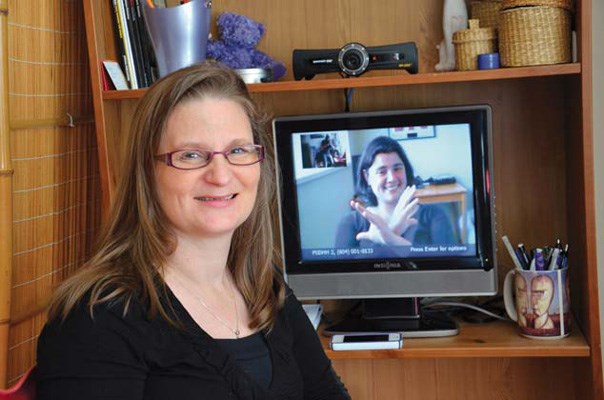For Burnaby resident Lisa Anderson-Kellett, communicating on the phone can be cumbersome. Like many people who are deaf or hard of hearing, Anderson-Kellett's options are somewhat limited to relaying typed messages through an operator or using a TTY, a machine used to type messages to other TTY users.
That's partly why Anderson-Kellett is working with a grassroots organization that's pushing the Canadian Radio-television and Telecommunications Commission to help bring in "video relay service," a video-based system that allows people to communicate with sign language through an interpreter who speaks to the hearing user on the other end of the line.
"Basically the consumer would be responsible for having the equipment, and perhaps the video relay service company would provide the video phone and the remote to make the calls. But someone has to pay for the service itself - the sign language interpreters, the technology set-up, the call centre, etc. That's what the CRTC is trying to figure out and to set up protocols and policies in regards to having a video relay service in Canada," Anderson-Kellett said, speaking through an operator who read her text messages over the phone and typed the NOW's questions in response. Anderson-Kellett is a spokesperson with the B.C. Video Relay Services Committee, which teamed up with the Canadian Association of the Deaf to organize a cross-Canada day of awareness on Sept. 21, where people gathered at CRTC offices, calling for a video relay service system that would be available across Canada.
A video relay services system is already in use in the U.S., and Telus and Bell are looking at offering the service in Canada. Both companies have submitted reports to the CRTC, the public body responsible for regulating telecommunications and broadcasting.
"The next step is for the CRTC to say yes to video relay service in Canada. They haven't made a decision yet. We've started asking for video relay service since as far back (as) 2006, and only in 2012 have things finally moved faster," Anderson-Kellett said.
The committee is asking the CRTC to decide by Dec. 31.
"We have been waiting long enough. They have already had enough time to study the Telus and Bell reports," she said.
Burnaby-New Westminster MP Peter Julian has also taken up the cause and introduced a motion in the House of Commons, calling on the CRTC to put a video relay service in place.
"For me it's a no-brainer," Julian said. "In an inclusive society where everybody can fully participate, you need to ensure there's access (to communication technology)."
Julian said that with video relay service, people can communicate through both American sign language and French sign language.
"That allows for a degree of communication you simply cannot get through old technology like TTY," he said.
Paulette Leclair, the CRTC's director of public affairs, responded to Anderson-Kellett's concerns in a letter and stated that the commission is looking into the issue.
"Canadians who are deaf and use sign language have been clear that the ability to make and receive telephone calls relayed by a sign language operator would better meet their needs," Leclair wrote. "The commission recognizes the diverse communications needs of Canadian and will continue to work to facilitate access to communications systems by all Canadians."
Anderson-Kellett participated in an 18-month video relay service trial, so she knows first-hand how much easier it is.
"For me, the biggest impact is having (the ability) to catch up with my hearing-family news. I am the only deaf person in my family, and I'm constantly left out of family news," she said.
With video relay service, she was able to participate in regular phone "catch-up" sessions with family members, but that ended along with the trial.
"It feels like going back in the dark ages with just using text and TTY," she said.
If a video relay service were in place, Anderson-Kellett could make doctor's appointments much faster, explain apartment issues to her landlord more clearly, and order a pizza with ease.
"It's a lot of waiting around without video relay service," she said.



